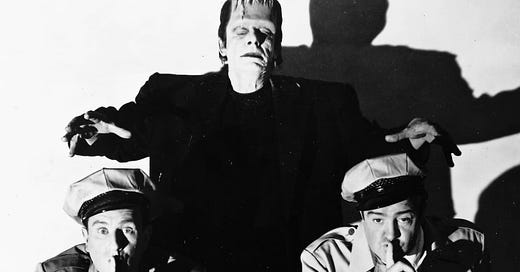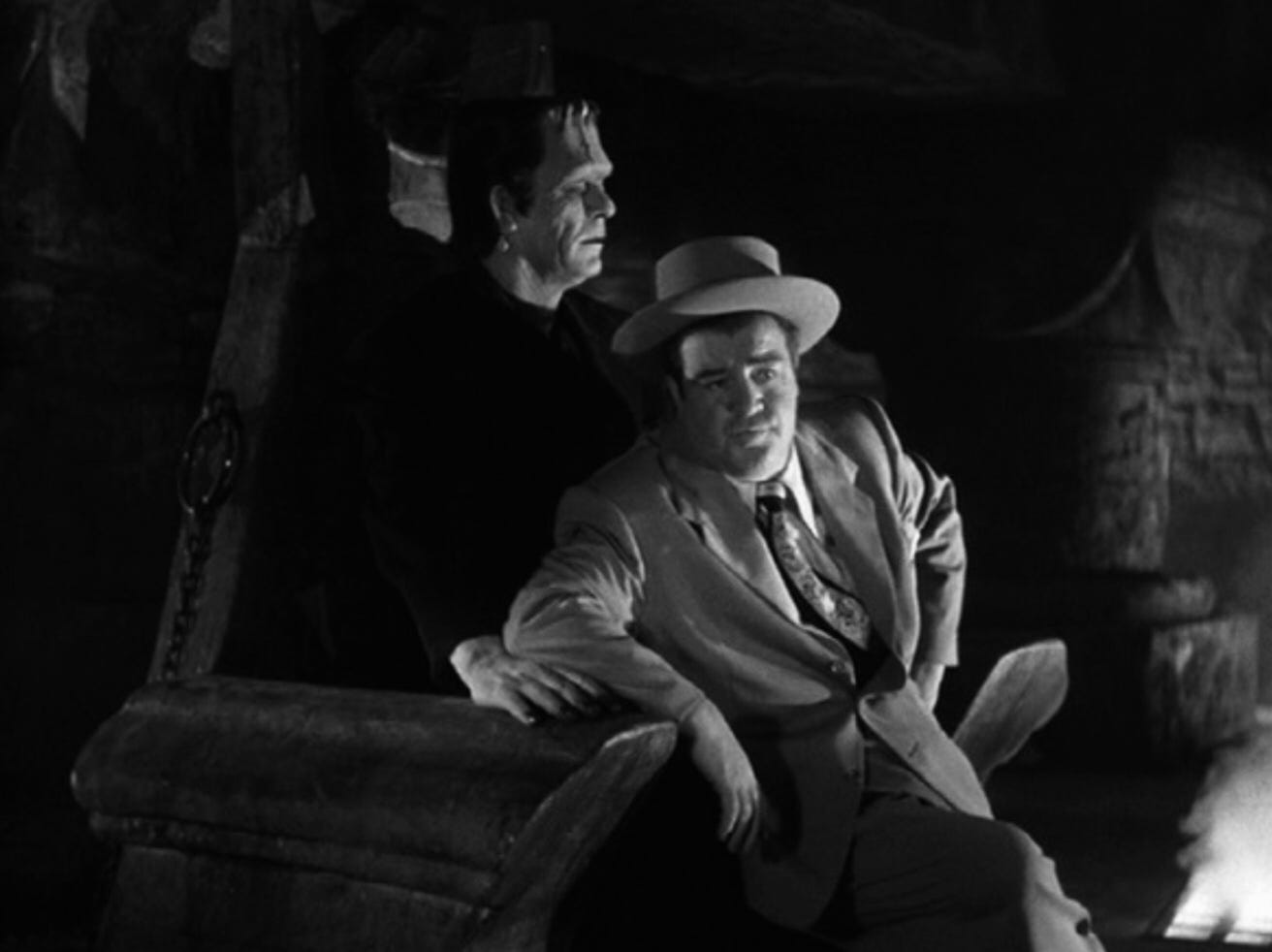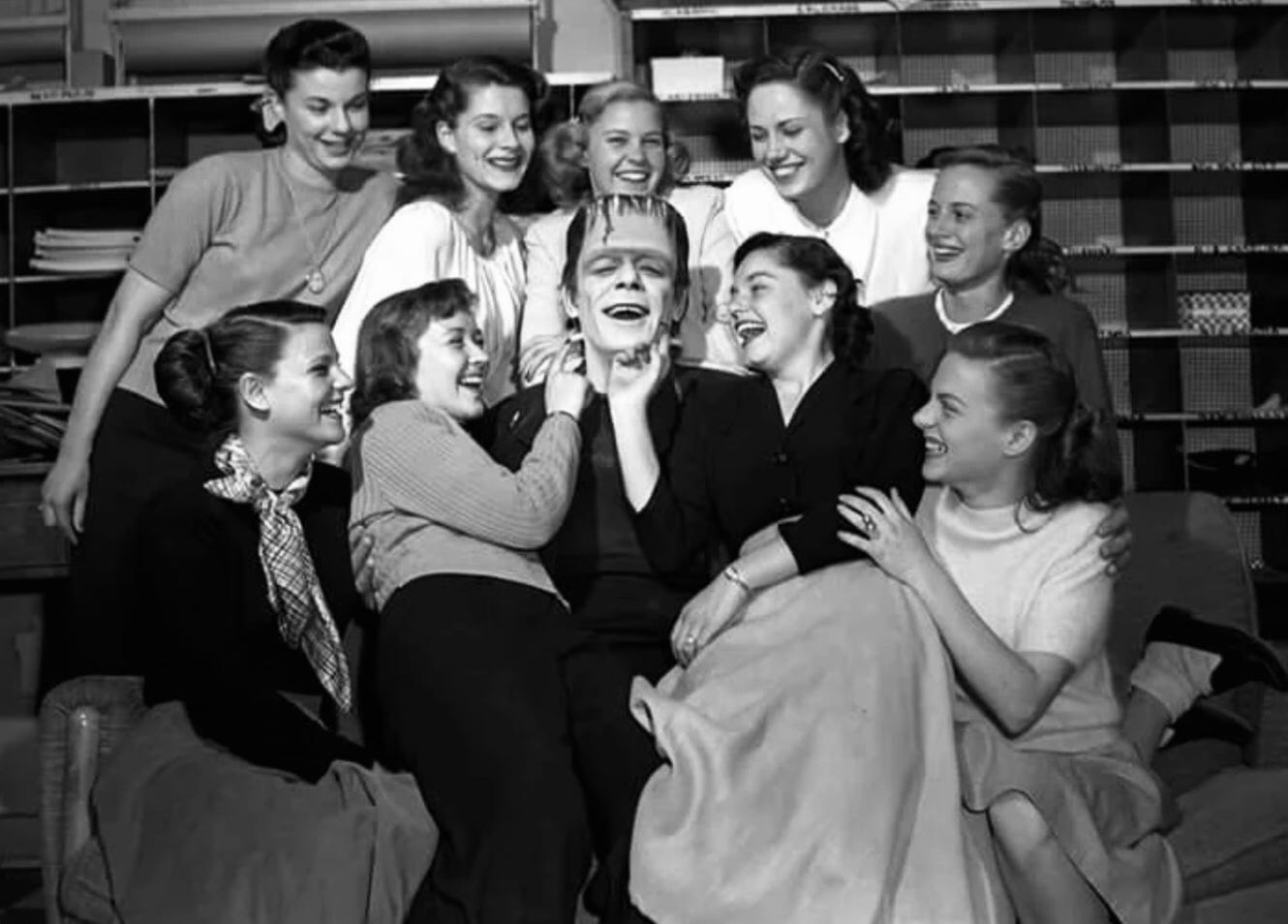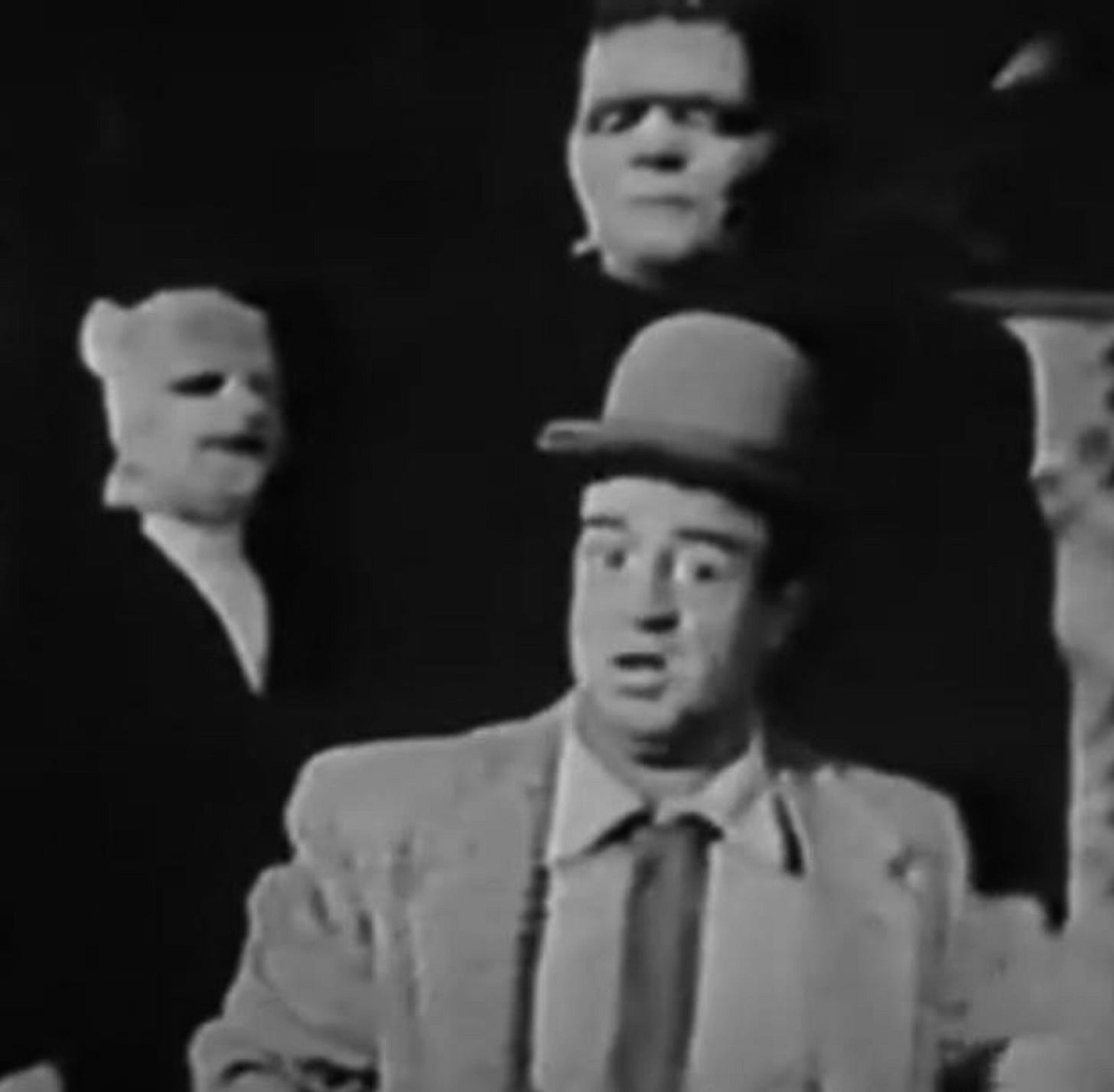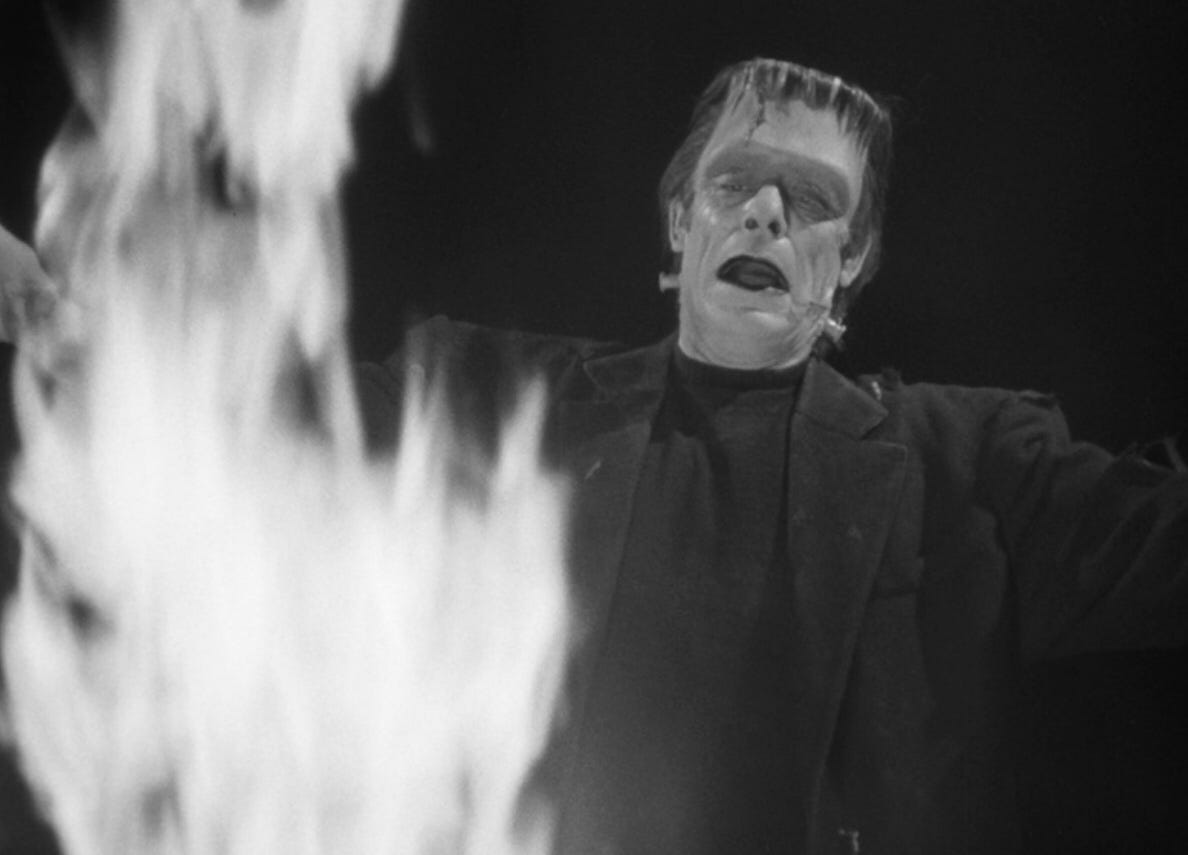Classic Horror Behind the Scenes: Frankenstrange (Part 2)
This time around, we’ll examine Glenn Strange’s work in perhaps his most famous film: ABBOTT AND COSTELLO MEET FRANKENSTEIN (1948).
By Bill Fleck, author of the Rondo-nominated book CHANEY’S BABY, available here.
It’s been a bad day for Wilbur Gray.
The short, chubby, 30-year-old shipping clerk has spent the night in jail, ostensibly because he’s made off with two incredibly valuable exhibits.
The first is a coffin containing the remains of—as he’s been told—“the original Count Dracula!”
The second is the corpse of Frankenstein’s Monster.
Wilbur knows he hasn’t made off with anything. He’s seen both Dracula and the Monster in action, and he knows they aren’t missing—they’ve escaped under their own steam. But nobody will believe him…not even Chick Young, his fellow clerk and best pal.
And now, somehow, Wilbur’s ended up alone in a secret dungeon in a stone castle that he’s been told by one Lawrence Talbot is actually “the house of Dracula.”
All of this is too much for the hyper-excitable Wilbur, who skulks around in the blackness, seeking some way out of this room…and this mess.
But it’s no use. He’s trapped. Defeated, he comes across a chair and flops down, hoping Chick will eventually find him.
But the chair feels somehow, well, strange. In an attempt to get more comfortable, he grips the armrest with his right hand…
…and then it hits him: he appears to have suddenly grown a second right hand.
Obviously confused, he shoots a glance toward his left hand. Yes, it’s still there where it belongs. He looks back to his right…and sure enough, there are still two…though even in the dark he can make out that one is much bigger than the other.
A quick count confirms it—he has three hands.
But are all three his?
Wilbur isn’t the brightest guy on the planet, but a plan flashes in his mind: he’ll smash his right hands with his left fist! If he feels pain in both, well, somehow the improbable has come true and he’s three-handed now.
But if there’s pain in only one…
Wilbur is about to ball up his left fist and execute, when a loud laugh bursts out in his ear right behind him.
“Heh, heh, heh! I can’t help it—sorry!”
And another take is ruined.
Lou Costello—the soon-to-be-42-year-old comic playing Wilbur—is outraged. He doesn’t want to shoot this scene to begin with. And now, because his co-star can’t stop laughing, he’s not even going to get through it?
His co-star is, of course, 48-year-old Glenn Strange…who is once again playing the Frankenstein Monster.
“Damn it, Glenn!” Costello explodes. “You’re trying to do that just to make it worse for me!” [1]
“No, of course not,” Strange replies. “I don’t know what the hell it is about you, but even on the back of your head, I can see what’s going on.”
Director Charles Barton, 45—and no stranger to Abbott and Costello (this is his fifth film with them)—concurs.
“Well, we began shooting the scene,” he’ll tell film historian Greg Mank years later, “and right in the middle of it, Glenn started to laugh. And, by God, he couldn’t stop!” [2]
Eventually the scene gets shot, and it becomes a highlight in a film filled with hilarious moments.
[Above: Strange couldn’t stop laughing shooting this scene. Costello initially thought that Strange was trying to sabotage him.]
But what is Glenn Strange doing back in the Monster’s makeup—along with Bela Lugosi as Dracula and Lon Chaney, Jr. as Lawrence Talbot/The Wolfman—shooting THE BRAIN OF FRANKENSTEIN two years after Universal execs have declared that the monsters are dead to them?
THE BEST LAID PLANS…
In short, the monsters are back—and Abbott and Costello are tolerated—because Universal’s decision to focus only on highbrow pictures (starting in 1946) has nearly brought the company to its knees. Newly merged with International, the studio’s bacon is saved by the likes of THE EGG AND I (1947), while the more sophisticated fair limps to the box office to die a slow death.
This is not lost on William Goetz, the suit in charge of production…and son-in-law to none other than Louis B. Mayer of MGM. Goetz hates Abbott and Costello, both personally and professionally. But he’s realistic. While it’s true that A&C aren’t Top-10 box office attractions anymore, they still rake in much-needed bucks. Goetz respects that.
So, when producer Robert Arthur, 38, pitches bringing back the Universal monsters to menace the waning comedy team in a picture, Goetz is reluctantly on board…as long as he doesn’t have to know much about it.
“I don’t think those guys are funny,” Goetz tells Arthur. “If I read the script, I might not think that it was funny, and anything I say might harm your picture. Good luck and God bless you.”
And just like that, the Universal monsters have new life, even if it is a comic one.
This is good news for just about everyone involved.
Bela Lugosi, 65, is back on the Universal lot for the first time in years, and playing Dracula on film for the first time since 1931. He’s being paid $8000 for his work. He needs it. Though constantly performing in summer stock, travel is expensive. And Bela is infamously loose with his money.
Luckily, the character of Dracula is carefully crafted here.
“There is no burlesque for me,” he will say. “All I have to do is frighten the boys, a perfectly appropriate activity. My trademark will be unblemished.”
Lugosi will, in fact, steal the film with one of his greatest performances. Sadly, this will not change his fortunes in Hollywood.
Also looking for an uptick in fortune is Lon Chaney, Jr.
Since being booted by Universal in late 1945, things have been tough for the 42-year-old actor. He’s appeared in only three films, and a proposed reinvention of his screen persona as a comedian over at Paramount hasn’t panned out. He’s being paid ten grand for this film, but he has some reservations. The script mildly burlesques his “baby,” and—knowing Lou Costello as he does—he’s worried what might happen to The Wolfman once the wildly unpredictable comic goes off-script. [3]
As for the Monster? Rumors fly that Boris Karloff has been offered the part. True or not, everyone in the know understands that Karloff isn’t going to appear…though he will later do paid promotions for the movie, provided that he doesn’t have to see it.
This, of course, leaves the door wide open for Glenn “Pee Wee” Strange to reprise the part. He signs a contract on January 12, 1948.
“DON’T LET ‘EM DO IT TO YOU, FRANKIE!”
Landing the part again is good news for the strapping actor. Since HOUSE OF DRACULA, he’s appeared in only four pictures.
Another bit of good news comes with a change in the makeup department. Jack Pierce, inventor of the original makeups for the Monster and The Wolf Man (among many others) has been canned. Unlike Chaney, Jr., Strange has had no disagreements with the temperamental Pierce. But Pierce’s painstaking, out-of-the-kit makeups take a long time and are uncomfortable, which is part of the reason the studio has let him go.
In his place is 30-year-old George Hamilton “Bud” Westmore. Along with his youth, Westmore has brought along streamlined makeup techniques that rely on foam rubber. Strange’s time in the makeup chair at the hands of Westmore’s assistant Jack Kevan is reduced to an hour as a result. [4]
[Above: By 1948, makeup artist Jack Pierce had been let go by Universal. Bud Westmore was now in charge, and used streamlined techniques. Strange was tended to by Westmore’s assistant Jack Kevan. The process took about an hour.]
“My make-up was a little lighter in the Abbott and Costello film than the Jack Pierce make-up…” Strange explains years later. “They did some things I liked very much. That is, they made the scars in pieces and kept them that way and put them on…I think by making the scars and putting them on, it saved quite a bit of time. But actually, for the color of the make-up, it seemed to me like it was a little lighter, with a somewhat silver base.”
Another pleasant surprise has to do with the fact that the Monster’s heavy boots have gone the way of the Dodo bird as well.
“[Y]ou know, the soles of those boots were four inches thick,” Strange will note. “You don’t see them, but they’re built up inside. It’s cork or something like it.”
Of course, this being an Abbott and Costello film, once Strange sets his cork boots on the set, almost anything goes.
True, his good buddy Lon, Jr. is there, and is always a good hang. And though Strange says that Lugosi is “hard to get to know,” there isn’t any animosity between them.
But the stars of the film? They’re something else. Not that they bother Strange directly, but…
“Bud and Lou had quite a chip on their shoulders about doing it, and they’d fight me like hell,” director Barton tells Greg Mank years later. “But I stood my ground with them, and so did Bob Arthur.”
But even director and producer standing their ground doesn’t stop the epic card games Abbott and Costello insist on playing on the set, eating up precious production time. Nor does it stop the seemingly constant pie fights.
“The pie bill on a picture like that was $3800 to $4800!” Barton will recall.
Luckily, Strange is exempt from attack—the Monster’s sleepy eyelids disqualify him as a target. Lugosi is exempt as well, out of respect…though the constant horsing around, the ad-libs, and the pranks pulled by Bobby Barber—A&C’s hired court jester—drive him to distraction.
“We should not be playing while we are working,” the exasperated actor will intone more than once.
Still, Strange—with his gregarious personality and good-natured sense of humor—has a great time on the film. At one point, actress Lenore Aubert—who plays Dracula’s evil scientist partner in the film—puts a leash on Strange in full makeup, and together with Bud, Lou, and Chaney (costumed as The Wolfman) takes a walk around the lot, delighting visitors.
At another point, Strange is lunching with Ann Blyth…who is costumed as a mermaid for MR. PEABODY AND THE MERMAID.
“Well, this tourist suddenly came around the corner and saw us,” Strange will recount. “She took one look at the crazy sight of a monster and a mermaid eating lunch together, let out a screech, and hit me in the face with her purse!”
[Above: Strange enjoyed shooting the film. He cavorted with the crew shooting MR. PEABODY AND THE MERMAID, often joined by his friend Lon Jr. He also visited the ladies in Universal’s mailroom.]
Strange is not the only one to take a hit in the face. At one point in the action, Costello as Wilbur has barricaded a door to keep the marauding Monster from getting to him, only to have the brute punch right through the structure. On this particular take, Costello missed his mark and took a full-on smack to the head. According to Barton, this is the version that appears in the finished film.
Friday, March 19, 1948. THE NEWS PILOT. Columnist Bob Thomas has news.
“Lon Chaney will appear as two monsters in ‘Abbott and Costello Meet Frankenstein,’” he reports. “Glenn Strange, playing Frankenstein’s monster, broke his foot while trying to throw an actress through a window. So Lon, who is the wolf man, slipped on Strange’s mask [sic] and completed the scene. You won’t know the difference on the screen.”
The situation is actually a lot more perilous than Thomas indicates.
It happens while shooting the climax. The newly-revived Frankenstein Monster has broken free of his bonds and is on a rampage. First up? Dr. Sandra Mornay, played by Lenore Aubert.
Or, in actuality, played in this scene by stunt double Helen Thurston.
The action calls for the Monster to throw Mornay through a laboratory window, like he did with Daniel in HOUSE OF FRANKENSTEIN.
But after the toss, Thurston’s safety wire malfunctions. She suddenly comes swinging right back at Strange.
“I broke the bones in my foot,” Strange explains. “I stepped on a camera cable. And those boots, you know, don’t have any counter in them. And it flopped over. We thought we’d lose about three days shooting.”
But when Chaney hears, he has a solution.
“I’ll put the makeup on,” he offers. “I’ll do it.”
Chaney suits up the very next day, throws Thurston through the window, and earns the gratitude of everyone concerned. [5]
Before long, Strange is back in action—with the aid of a hidden brace—chasing the other characters around the eerie mansion and grounds…when not being reduced to laughs thanks to the wild antics and hilarious ad-libs of Lou Costello.
July 24, 1948. ABBOTT AND COSTELLO MEET FRANKENSTEIN opens in Los Angeles.
It’s a sensation.
Eventually, it rakes in $3.2 million, close to $350 million at this writing. It puts Abbott and Costello back on top. And in 1949, it launches a new but brief side hustle for Strange…
He appears on stage as the Monster, together with Lugosi as Dracula.
[Above: Though Strange thought that Lugosi was “hard to get to know,” they appeared live in costume together briefly in 1949, performing in spook shows tied to screenings of ABBOTT AND COSTELLO MEET FRANKENSTEIN. They’re pictured here on the film set.]
Such road shows are nothing new to Lugosi; it’s how he’s been eking out a living for years. But the experience is an interesting one for Strange.
To begin with, the show is tied in with screenings of ABBOTT AND COSTELLO MET FRANKENSTEIN.
The opus begins with a local magician. Following his act, he turns to the audience and dramatically announces, “[W]e have special guests that will come on this stage direct from Europe!”
The house lights dim. The magician enthusiastically waves his hands around. A sudden flash and a cloud of smoke envelops the stage. And when the smoke clears, there stands Lugosi in full Dracula mode.
“I present Dracula, the vampire!” the magician intones.
The audience breaks out in applause. When it finally dies down, Lugosi gestures toward the back of the auditorium.
“Come to me!” his deep voice rumbles. “I command you to come to me!”
The house lights slowly get brighter. And there, stalking down the aisle—seemingly eight feet tall—is Strange as the undying Monster.
The audience shrieks.
The Monster joins Dracula on stage. A henchman—described by noted memorabilia collector Bob Burns as “an Ygor-type guy”—snatches a random girl from the audience. [6]
She’s dragged toward a guillotine on stage. The Monster viciously grabs her. Dracula gleefully instructs him to put a hood on her, then force her head into the guillotine. Once she’s in position, the magician yanks the rope…
…the blade comes whooshing down…
…and the girl’s severed head spills into a basket!
The audience screams again.
But it’s not over.
The Monster fiendishly pulls the girl’s head out of the basket. He turns to the crowd…
…and flings her head at them! [7]
The screams are even louder now.
Excellent, over-the-top, Grand Guignol stuff for sure, but—sadly—short-lived.
As Strange will later explain, Lugosi—who’d recently resettled in California—needed a break from traveling the country.
“IF I MADE A GOOD MONSTER, THE CREDIT GOES TO ONE OF THE NICEST GUYS I KNOW.”
Lugosi or no, Glenn Strange makes a series of personal appearances at screenings of ABBOTT AND COSTELLO MEET FRANKENSTEIN. At some point, he’s made aware that Boris Karloff—who Strange says was in New York at the time—has been correcting journalists who believe that he, Boris, played the Monster in the film.
No, Karloff explains, that isn’t me. It’s Glenn Strange.
“So, right after I read that, when I’d finished the act, I’d always come out for two or three minutes and talk to the audience,” Strange will recall.
“If you folks liked me as the Monster in ABBOTT AN COSTELLO MEET FRANKENSTEIN,” Strange would begin, “then I want to give most of the credit to the man who created it, and the man who helped me in the show that I did with him where he did the doctor. And he coached me on the walk and the movements and so forth. And if I made a good Monster, the credit goes to one of the nicest guys I know, Boris Karloff.”
When Karloff hears about this, he’s very touched indeed.
“HEY, ABBOTT! I SCARED FRANKENSTEIN!”
February 21, 1954. THE COLGATE COMEDY HOUR, with frequent guest stars Bud Abbott and Lou Costello.
The most famous sketch of the night is a promotion for Universal’s latest monster show, THE CREATURE FROM THE BLACK LAGOON. [8]
The premise is basically a reprise of A&C’s Haunted House routine. Lou sees and hears frightening things no one else does, things that turn out to be real. In this case, the phantoms appear in what’s supposed to be the prop department at Universal Studios.
One of these props is Glenn Strange as Frankenstein’s Monster.
[Above: Strange appeared unbilled as the Monster on THE COLGATE COMEDY HOUR with Abbott and Costello in 1954. Wikipedia credits Strange with nearly 500 TV appearances.]
In something of a replay of ABBOTT AND COSTELLO MEET FRANKENSTEIN, the uncredited Strange emerges in the makeup from a creaky box and lurks behind the oblivious comic…until Lou bends over and sees the Monster’s gigantic boots behind him. This results in an extended pantomime as Lou attempts to convince himself that he’s imagining things. When he finally whirls around to confront his demons, the Monster is startled and falls back into the creaky box.
“Hey, Abbott!” the giddy Costello exclaims. “I scared Frankenstein!”
It’s only then that he realizes the Creature from the Black Lagoon—played by an unbilled Ricou Browning—is lurking behind him as well. He collapses in fright as the curtain closes.
SAM THE BARTENDER
For non-Monster Kids, Glenn Strange’s most famous role is on TV’s GUNSMOKE, where he plays Sam the Bartender for a dozen years. He allegedly gets the part because his buddy James Arness—who stars in the series as Marshall Matt Dillon—likes to work with other tall guys.
[Above: Strange played Sam the Bartender for twelve years on TV’s GUNSMOKE. Lung cancer forced him into retirement.]
Strange fills his downtime by dabbling in electronics. One of his favorite hobbies is fixing up old TV’s in his garage. He also joins up with Chuck Wagon Trailers, a group of cowboys and stuntmen who want “to preserve the old ways. Most had ridden the trails we now dream of and they saw the clouds of change…knowing that no more could they ride with the trail herds and join the round-ups as in days gone by.” [9]
It's through Chuck Wagon Trailers that Strange meets Joel Towler, a fellow electronics enthusiast.
“I have never met a kinder, nicer gentleman than Glenn…” Towler will say later. “I don’t think Glenn was capable of saying an unkind remark about any human being. For such a big guy, he was gentle in spirit, and always polite.”
Sadly, Strange is afflicted with lung cancer in his final years. He stays on GUNSMOKE for as long as he can, but eventually his illness will force him to retire.
Legend has it that he is able to muster one last public performance before he checks out. It’s July 12, 1973, and Strange has just heard that his bud Lon Chaney, Jr. has died at 67. Bob Burns, working for a CBS affiliate at the time, reaches out to him.
Listen, Burns explains. Chaney’s just died, and I can’t find anyone to go on the air about him. Do you think you can do it?
Strange is certain he can. He nobly rises from his sickbed and speaks about his friend. [10] A little more than two months later—on September 20, 1973—Glenn dies himself at the age of 74.
A STRANGE LEGACY
He was called “the meanest man in the world” in his press releases, but was actually one of the nicest. So it goes in Tinseltown.
As noted in Part 1, Glenn Strange appeared in more than 200 films. He was also ubiquitous on television. [11] But he’s best remembered today for two roles: Frankenstein’s Monster and Sam the Bartender.
So, as the Monster, how does he stack up?
Well, regular readers of this blog know that I spend too much time scrolling through Classic Monster cites on social media. As such, I take in a lot of commentary…even while I shamelessly share links to my articles. (Hey, I gotta make people aware that they exist somehow, or nobody’s gonna read ‘em.)
Okay, so I haven’t compiled any hard data, but the general impression I get on Frankenstrange is this:
Strange comes in a solid second to Boris Karloff among the actors who played the Monster in the classic 1930s-1940s films.
In fact, there is a significant percentage of Monster Kids who believe that Strange looks the most impressive in the makeup.
And there are a few who believe Strange actually surpasses Karloff in the role.
[Above: Strange in the climactic scene of ABBOTT AND COSTELLO MEET FRANKENSTEIN. Popular consensus has Strange coming in second only to Boris Karloff in the quality of his performance as the Monster.]
I don’t think I’m being too controversial here when I say that I believe Karloff was the best. His take on the Monster made FRANKENSTEIN (1931) what it is. And though he disliked elements of both BRIDE (1935) and SON (1939), he didn’t let that stop him from bringing genuine pathos to the part.
As for Lon, Jr.? Anyone who knows me knows I love that guy. And, like Karloff, he knew how to bring the pathos, too. (See OF MICE AND MEN or THE WOLF MAN.) However, this quality is oddly missing from his Monster in GHOST (1942). Missing, because it wasn’t in the script. And modern scholarship has shown that Chaney played the character exactly as written.
Still, GHOST is the last time that the Monster is featured as a main character. By the time Bela Lugosi plays him in FRANKENSTEIN MEETS THE WOLF MAN (1943), he’s decidedly become a supporting part.
What to say about the much-maligned Bela? He, too, played the part as written. Blind. Weakened. Saddled with Ygor’s “sly and sinister brain,” and looking to rule the state. As such, his casting made sense…in theory. What went wrong? Did he deliver Curt Siodmak’s dialogue in a hilariously bad way, as Siodmak always claimed? Or was Siodmak’s over-the-top dialogue to blame in-and-of itself?
I vote for the latter, having read it for myself.
But whatever you choose to believe, there’s no doubt that Bela’s turn as the Monster was dealt a killing blow when the dialogue—and all references to the Monster’s blindness—was cut.
This brings us to Strange.
True, in HOUSE OF FRANKENSTEIN, he isn’t given much to do. As one critic put it—and it slips my mind exactly who it was—“The ice doesn’t seem to have hurt the Wolf Man’s hairy hide, but the Monster is rendered comatose.” [12]
But when he does get up, throwing Daniel out a lab window and carrying Dr. Niemann into the swamp, he’s huge, lively, and definitely shows his Karloff training in both his facial expressions and body gestures.
It’s too bad we don’t see more of him.
HOUSE OF DRACULA isn’t as good. He lies around the entire time. And when he finally gets up, most of his action is handled by footage cut in from GHOST. It’s like he’s gone from supporting character to stage prop.
So, ABBOTT AND COSTELLO MEET FRANKENSTEIN is a very good thing for Strange and the Monster, because at least his story doesn’t have to end like that!
Plus, A&C MEET FRANK gives Strange a lot to do. He has lines: “Yes, Master.” Plus, even while weakened, he’s not just lying around. He’s hauling Dracula’s bulky coffin. He’s expertly scaring Wilbur Gray in a secret dungeon.
And when he gets up? Oh, it’s on!
Sure, it’s Chaney who throws the stunt double through the window, but it’s all Strange after that. And he’s never looked bigger or more menacing.
Okay, he’s not overly bright. Costello tricks him into thinking that he, Costello, is Dracula. Costello also manages to trip him up over a bed and cover him with a blanket.
And, of course, the Monster is destroyed while walking toward fire. Can anyone imagine Karloff’s creature doing that?
But in all of this—the lurking, the stalking, the silly slapstick—Strange is believable. And he looks scary as hell.
What better legacy is there for a horror film actor than that?
(For FRANKENSTRANGE PART 1, follow this link.)
[Above: Some newspaper clips featuring Glenn Strange. Note his designation as “the meanest man in the world.” In real life, Strange was anything but.]
NOTES
[1] Infamously, Costello had not wanted to make this film, which was initially entitled THE BRAIN OF FRANKENSTEIN. See my blog here for further details. Also of note: Strange had worked with Abbott and Costello previously in THE WISTFUL WIDOW OF WAGON GAP (1947), so he knew what to expect…and still couldn’t help himself.
[2] Mank, p. 160.
[3] Sadly, he’s correct. The Wolfman becomes Costello’s punching bag. I believe the treatment of his beloved character is partially to blame for Chaney’s suicide attempt in April of 1948. See my book, CHANEY’S BABY.
[4] Some contemporaneous news reports (e.g., “More Time for Horror” in the March 7, 1948 edition of THE OAKLAND TRIBUNE on p. 84) and current fan sites insist that both Chaney and Strange are wearing masks in ABBOTT AND COSTELLO MEET FRANKENSTEIN. This isn’t true. The studio considered using masks as a cost-saving measure, “but quickly reversed themselves, allowing Barton to use makeup of a type comparable to earlier horror films” (Rhodes and Kaffenberger).
[5] Except maybe that of Thurston. She catches some shards of fake glass in her eyes and has to go to the hospital. U-I increases her pay for the job to $300 (from $55).
[6] Burns, who has said he was closer to Strange than to his own father, saw one of the shows, and guesses that she was probably a plant.
[7] According to Burns, the head “was actually a head of cabbage.”
[8] The sketch has since been marketed on various digital media as ABBOTT AND COSTELLO MEET THE CREATURE FROM THE BLACK LAGOON.
[9] www.chuckwagontrailers.com
[10] The reader should know that I’m not sure this story is true. I’ve only found anecdotal evidence for it (such as TRIVIA on imdb.com), and I can’t seem to find any video of the broadcast anywhere. I’d like it to be true, since it’s in character for Strange, but feel free to draw your own conclusions.
[11] Wikipedia credits him with 300 films and 500 TV shows!
[12] Or words to that effect. I’m paraphrasing.
SOURCES
ABBOTT AND COSTELLO MEET FRANKENSTEIN. Outtakes. Youtube.com. Web.
Anderson, Chuck (Webmaster). “Glenn Strange: Western Villain and Frankenstein Monster.” THE OLD CORRAL. www.b-westerns.com. Web.
Fleck, Bill. CHANEY’S BABY. New York: Just Pay the Ransom Music, 2021. Print.
Mank, Gregory William. IT’S ALIVE! New York: AS Barnes & Co., Inc, 1981. Print.
Rhodes, Gary D. and Bill Kaffenberger. NO TRAVELOR RETURNS: THE LOST YEARS OF BELA LUGOSI. Albany, Georgia: BearManor Media, 2016. Ebook.
Staffer, M.M., Don Glut, and Bob Burns. “Special Interview: Glenn Strange.” MODERN MONSTERS 4, October 1966. Print.
Thomas, Bob. BUD & LOU. Philadelphia/New York: J.B. Lippincott Company, 1977. Print.
Thomas, Bob. “Hollywood: Double Monster.” NEWS-PILOT. March 19, 1948, p. 2. Print.
NOTE: The photographs contained herein are used for educational purposes only. I do not own the copyrights.
